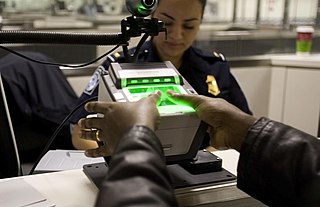
The United States Department of Homeland Security (DHS) is the U.S. federal executive department responsible for public security, roughly comparable to the interior or home ministries of other countries. Its stated missions involve anti-terrorism, border security, immigration and customs, cyber security, and disaster prevention and management.
The National Security Entry-Exit Registration System (NSEERS) or INS Special Registration was a system for registering certain non-citizens within the United States, initiated in September 2002 as part of the War on Terrorism. Portions were suspended as of April 27, 2011, and the entirety of the regulation was removed on December 23, 2016.
U.S. Immigration and Customs Enforcement is a federal law enforcement agency under the U.S. Department of Homeland Security. ICE's stated mission is to protect the United States from cross-border crime and illegal immigration that threaten national security and public safety.

United States Visitor and Immigrant Status Indicator Technology is a U.S. Customs and Border Protection (CBP) management system. The system involves the collection and analysis of biometric data, which are checked against a database to track individuals deemed by the United States to be terrorists, criminals, and illegal immigrants. US-VISIT is accessed by 30,000 users from federal, state, and local government agencies. Upon Presidential approval of the 2013 Continuing resolution the US-VISIT program officially became the Office of Biometric Identity Management (OBIM), save for portions of the agency which performed overstay analysis being transferred into U.S. Immigration and Customs Enforcement and biometric Entry and Exit operations which became a part of U.S. Customs and Border Protection.

The United States Customs Service was a federal law enforcement agency of the U.S. federal government. Established on July 31, 1789, it collected import tariffs, performed other selected border security duties, as well as conducted criminal investigations.

United States Customs and Border Protection (CBP) is the largest federal law enforcement agency of the United States Department of Homeland Security. It is the country's primary border control organization, charged with regulating and facilitating international trade, collecting import duties, as well as enforcing U.S. regulations, including trade, customs, and immigration. CBP is one of the largest law enforcement agencies in the United States. It has a workforce of more than 45,600 federal agents and officers. It is headquartered in Washington, D.C.

The Board of Immigration Appeals (BIA) is an administrative appellate body within the Executive Office for Immigration Review of the United States Department of Justice responsible for reviewing decisions of the U.S. immigration courts and certain actions of U.S. Citizenship Immigration Services, U.S Customs and Border Protection, and U.S. Immigration and Customs Enforcement. The BIA was established in 1940 after the Immigration and Naturalization Service was transferred from the United States Department of Labor to the Department of Justice.
U.S. Citizenship and Immigration Services (USCIS) is an agency of the United States Department of Homeland Security (DHS) that administers the country's naturalization and immigration system. It is a successor to the Immigration and Naturalization Service (INS), which was dissolved by the Homeland Security Act of 2002 and replaced by three components within the DHS: USCIS, Immigration and Customs Enforcement (ICE), and Customs and Border Protection (CBP).
Form I-94, the Arrival-Departure Record Card, is a form used by U.S. Customs and Border Protection (CBP) intended to keep track of the arrival and departure to/from the United States of people who are not United States citizens or lawful permanent residents. While the form is usually issued by CBP at ports of entry or deferred inspection sites, USCIS can issue an equivalent as part of the Form I-797A approval notice for a Form I-129 petition for an alien worker or a Form I-539 application for extension of stay or change of status.

The Naturalization Act of 1906 was an act of the United States Congress signed into law by Theodore Roosevelt that revised the Naturalization Act of 1870 and required immigrants to learn English in order to become naturalized citizens. The bill was passed on June 29, 1906, and took effect September 27, 1906. It was repealed and replaced by the Nationality Act of 1940. It was modified by the Immigration Act of 1990.
The Security Through Regularized Immigration and a Vibrant Economy Act of 2007 or STRIVE Act of 2007 is proposed United States legislation designed to address the problem of illegal immigration, introduced into the United States House of Representatives. Its supporters claim it would toughen border security, increase enforcement of and criminal penalties for illegal immigration, and establish an employment verification system to identify illegal aliens working in the United States. It would also establish new programs for both illegal aliens and new immigrant workers to achieve legal citizenship. Critics allege that the bill would turn law enforcement agencies into social welfare agencies as it would not allow CBP to detain illegal immigrants that are eligible for Z-visas and would grant amnesty to millions of illegal aliens with very few restrictions.
During the 18th and most of the 19th centuries, the United States had limited regulation of immigration and naturalization at a national level. Under a mostly prevailing "open border" policy, immigration was generally welcomed, although citizenship was limited to “white persons” as of 1790, and naturalization subject to five year residency requirement as of 1802. Passports and visas were not required for entry into America, rules and procedures for arriving immigrants were determined by local ports of entry or state laws. Processes for naturalization were determined by local county courts.

The federal government of the United States empowers a wide range of federal law enforcement agencies to maintain law and public order related to matters affecting the country as a whole.
The FBI Name Check is a background check procedure performed by the Federal Bureau of Investigation for federal agencies, components within the legislative, judicial, and executive branches of the federal government; foreign police and intelligence agencies; and state and local law enforcement agencies within the criminal justice system. The FBI Name Check is performed by the FBI as a part of the National Name Check Program, which dates back to Executive Order 10450 that was issued during the Eisenhower Administration. The FBI Name Check for an individual involves a search of the FBI's Central Records System Universal Index for any appearance of the name of the individual, as well as close phonetic variants and permutations of that name, in any of the records stored in the Universal Index. If any such occurrences are found, the Name Check also involves retrieval and analysis of the relevant paper and electronic files from local FBI offices and from other law-enforcement agencies.
The Office of Immigration Statistics (OIS) is an agency of the United States Department of Homeland Security that operates under the Office of Strategy, Policy, and Plans.

The American Civics Test is an oral examination that is administered to immigrants who are applying for U.S. citizenship. The test is designed to assess the applicants' knowledge of U.S. history and government. US Citizenship and Immigration Services (USCIS) administers the test as part of the naturalization process.
Expedited removal is a process related to immigration enforcement in the United States where an alien is denied entry to and/or physically removed from the country, without going through the normal removal proceedings. The legal authority for expedited removal allows for its use against most unauthorized entrants who have been in the United States for less than two years. Its rollout so far has been restricted to people seeking admission and those who have been in the United States for 14 days or less, and excludes first-time violators from Mexico and Canada.

Systematic Alien Verification for Entitlements (SAVE) is a program managed by United States Citizenship and Immigration Services (USCIS), a branch of the U.S. Department of Homeland Security (DHS). SAVE facilitates lookups on the immigration and nationality status of individuals in the United States. It is an intergovernmental initiative designed to help federal, state, tribal, and local government agencies, or by a contractor acting on the agency's behalf, to determine eligibility for benefits, licenses or grants, government credentials, or to conduct background investigations. It is one of two programs that uses the Verification Information System (VIS). The other program is the Electronic Employment Eligibility Verification Program, also known as E-Verify, and is used by employers to verify the immigration status of employees. For additional verification, SAVE relies on the Person Centric Query System (PCQS).
The Priority Enforcement Program is a program by U.S. Immigration and Customs Enforcement (ICE), the agency responsible for immigration enforcement in the interior of the United States, under the U.S. Department of Homeland Security (DHS). PEP was an ICE program that worked with state and local law enforcement to identify illegal aliens who come in contact with state or local law enforcement, and remove those who are removable. PEP was announced by DHS Secretary Jeh Johnson in a November 20, 2014 memo as a replacement for Secure Communities (S-COMM). It builds on an updated list of immigration enforcement priorities released in another memo by Johnson issued on the same day.
The Immigration Examinations Fee Account (IEFA) is an account in the Treasury of the United States into which all revenues collected from fees for immigration and naturalization are deposited, and that is used to fund the costs associated with providing the immigration and naturalization benefits. The account funds most of the operations of the United States Citizenship and Immigration Services (USCIS), the sub-agency of the U.S. Department of Homeland Security that is tasked with most of the associated work.











